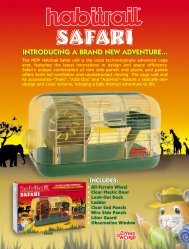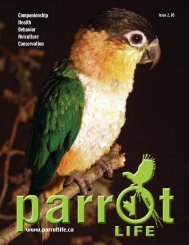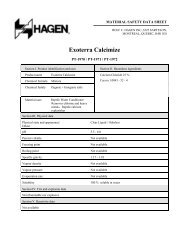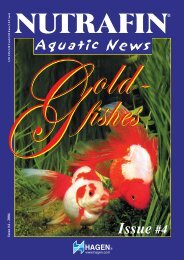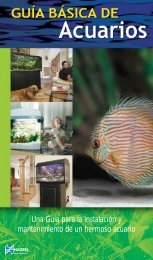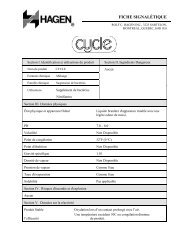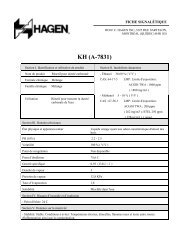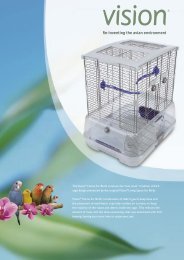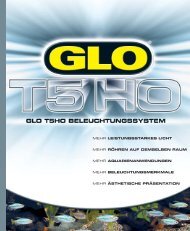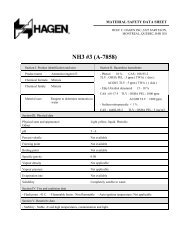parrotLife_Printers-3 (Page 1) - Rolf C. Hagen Inc.
parrotLife_Printers-3 (Page 1) - Rolf C. Hagen Inc.
parrotLife_Printers-3 (Page 1) - Rolf C. Hagen Inc.
You also want an ePaper? Increase the reach of your titles
YUMPU automatically turns print PDFs into web optimized ePapers that Google loves.
44<br />
Dr. Corina Lupu<br />
is a graduate of the<br />
Faculty of Veterinary<br />
Medicine of the<br />
University of Montreal<br />
and is a board certified<br />
specialist in the field of<br />
avian medicine. Her<br />
career, which spans<br />
25 years, began with a<br />
3-month apprenticeship<br />
in Chicago with the late<br />
Dr. Ted Lafeber Sr.<br />
Her appreciation and<br />
respect for birds born<br />
out of this experience<br />
have intensified over<br />
the years.<br />
Dr. Lupu owns and<br />
operates the Montreal<br />
Bird and Exotic<br />
Veterinary Hospital,<br />
which is devoted exclusively<br />
to birds and<br />
exotic animals.<br />
She also teaches avian<br />
medicine at the Faculty<br />
of Veterinary Medicine<br />
of the University of<br />
Montreal and has lectured<br />
over the years to<br />
various groups,<br />
professional and<br />
non-professional alike.<br />
Dr. Lupu has developed<br />
a special interest in<br />
Parrot behaviour and<br />
advocates vigorously<br />
for responsible parrot<br />
ownership.<br />
VETERINARIAN CASE REPORT<br />
A case of nasal<br />
infection in a<br />
52-year-old parrot<br />
A 52-year-old Cuban Amazon named Coco was<br />
brought to us because she had developed<br />
three small "holes" in her upper beak. This was<br />
an unusual presentation. The holes were situated<br />
just below the right nostril and appeared as<br />
though they had been drilled into the horny<br />
beak. These 1-2 mm diameter perforations<br />
were filled with what appeared to be dried<br />
blood. We also found that the right cere, the<br />
fleshy area around the nostril, was swollen and<br />
red. She scratched this area often, rubbing her<br />
face on her perch or using her foot.<br />
The swollen nostril indicated that there was an<br />
inflammation in the nasal cavity. We could not<br />
explain the holes in the beak.<br />
The rest of her physical examination was normal.<br />
She was fed a balanced diet. Blood tests<br />
were normal and X-rays as well. The internal<br />
nares were cultured and after several tries, a<br />
bacterium was isolated. This bacterium is one<br />
that thrives in the upper respiratory system,<br />
and causes damage by producing a substance,<br />
which destroys living tissues.<br />
We knew we were dealing with an infection of<br />
the right nasal cavity and a possible fistula (a<br />
tunnel burrowed by the bacteria) from the<br />
inside of the nasal cavity, through the bony and<br />
horny tissues of the beak, to the outside.<br />
We treated the bird with a combination of<br />
antibiotics administered by injection and locally<br />
by flushing the nasal cavity with medicated<br />
saline. Over the course of a month, we saw the<br />
dark crusts in the holes clear up, the cere<br />
return to normal, and the itching stop. All was<br />
well, or so we thought.<br />
Periodic follow-ups showed that the holes were<br />
slowly migrating down the beak as the beak<br />
grew. Eventually they disappeared. However,<br />
twelve months after the first incident, new holes<br />
appeared, and the cere was again inflamed.<br />
We repeated the identical treatment, as it had<br />
been successful the first time, but for a longer<br />
duration. We believed we were dealing with a<br />
recurrence of the condition, because not ALL<br />
the bacteria had been eliminated during the<br />
first course of treatment and we thought we<br />
might be dealing with a very tenacious or<br />
resistant strain. Once more, the treatment was<br />
effective, the inflammation subsided, the hole<br />
migrated down the beak and all returned to<br />
normal for twelve months.<br />
At that time, a third recurrence of the problem<br />
made us look deeper into the situation. We no<br />
longer believed the treatment to be at fault.<br />
Was this birds’ immune system weakened by<br />
her advanced age? Was there an unchecked<br />
source of contamination?<br />
After thorough discussions with the clients, we<br />
realized that Coco used a rope perch, to<br />
soothe her aging tender feet. This perch had<br />
been in the cage all along and Coco had been<br />
rubbing her beak on it from the beginning.<br />
Furthermore, the condition always appeared in<br />
the spring when Coco ate more fruit, wiping the<br />
fruit residue from her beak onto to perch.<br />
Although the perch was wiped clean regularly,<br />
it was never cleaned in depth.<br />
The suspect perch was replaced by a new<br />
one, which was henceforth washed in the<br />
dishwasher weekly.<br />
The take home lessons of Coco’s adventure are<br />
twofold. Firstly, debris can accumulate in the<br />
most unsuspected areas in even a meticulously<br />
clean environment: the perch in this case,<br />
under cage bottom pull out trays, at the junction<br />
of cage wires, in the hinges of food clips,<br />
etc. Bacteria are microscopic and hide in the<br />
nooks and crannies of a bird’s environment.<br />
Most will not survive unless they are surrounded<br />
by organic material such as secretions,<br />
droppings or food debris. Hence, while<br />
disinfecting is important, it is more important




